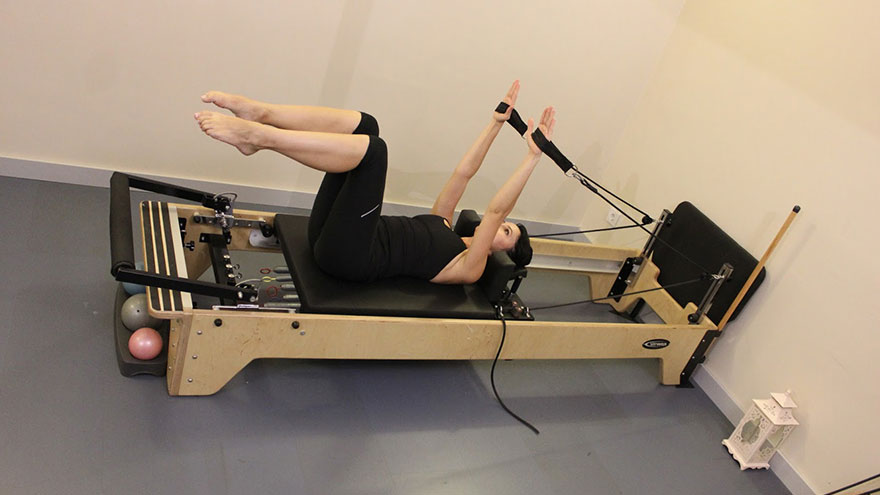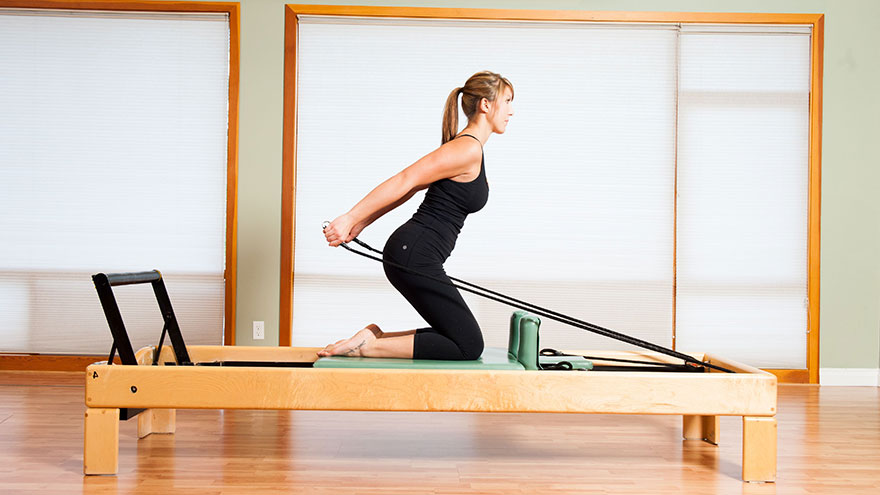How to Use a Jump Board on the Pilates Reformer
Pilates is an incredible core workout but it can seem a little slow at times. To shake up your Reformer equipment routine a little, and add a tiny bit of cardio, you can attach a jump board to the Reformer. Read on to find out how
Things You’ll Need
- Pilates Reformer
- Jump Board
Attaching the Jump Board

1. Locate the holes on the Reformer where the jump board’s bungee cord will be hooked into the Reformer.
It is under the footbar, and if your Reformer has wheels, you will find it above the wheels. If your Reformer has legs, you might notice two possible holes. Use the larger holes.
2. Adjust the footbar’s horizontal position, by pulling out the black knobs and sliding the footbar unit, so that two holes are showing on the bottom sides of the Reformer.
Unlike other Reformer moves where you adjust the number of holes showing based on your height, jump board use requires two holes showing no matter what your size.
3. Adjust the footbar’s vertical position, by pressing in the black metal flaps, so that one hole is showing above the footbar.
4. Place the unpadded part of the jump board in the groove to the front of, and below, the footplate.
5. Locate the bungee cord on the back of the jump board.
6. Pull one hook on the bungee cord down to the larger hole below the footbar.
Make sure the cord gets stretched over the footbar, not behind it.
7. Pull the other hook down to its corresponding hole.
This side might be considerably more difficult. You might have to give yourself quite a bit of slack on the bungee cord to get the hook into the hole.
8. Make sure the jump board is secure by rocking it slightly with your hand.
A Basic Exercise on the Jump Board

9. Attach a yellow and red spring.
10. Lay down on the carriage looking up.
Rest your arms at your sides.
11. Place your feet on the jump board so they are about hip width apart and parallel to each other.
Your knees will be bent.
12. Make sure your spine is in neutral position.
This means a slight tilt to the tailbone and a small space between the small of your back and the carriage.
13. Tighten your abdominal muscles.
Surprisingly, this exercise is more about your abs than your legs. Keeping your abs tight helps you land gently on the jump board instead of slamming down on it. Properly executed jump-board exercises will be relatively quiet and will not move the Reformer. If your Reformer moves across the floor during this exercise you need to focus more on tightening your abs and landing softly.
14. Inhale.
15. Exhale and jump.
16. Land softly on your toes.
Then let the balls of your feet touch, and then your heels.
17. Bend your knees.
18. Jump again.
19. Repeat this motion and jump 8 to 12 times.
20. Concentrate on landing softly.
When you feel comfortable with this jump, there are plenty of jump modifications to keep you interested.
Tips and Warnings
- There are a number of other foot and leg variations to keep your routine fresh.
- Use the jump board for 10 to 15 minutes.
- When you become more advanced, you can lighten up the spring load.
- The installation instructions and spring settings for this article are specific to the Allegro Reformer. Check your handbook for instructions specific to your Reformer.
- As with any exercise program, check with a doctor before beginning Pilates.
- It is recommended you take at least one or two classes with a Pilates instructor before doing these exercises on your own to make sure you have correct form, and to prevent injury.
You Might Also Like :: How to Make a Tumbling Mat

